A pure sine wave inverter will help you establish a reliable, high-quality power source whenever, wherever.
These devices convert direct current (DC) power from a battery or other DC power source into high-quality alternating current (AC) that you can use in your RV, boat, or throughout your home.
It stands to reason why a pure sine wave inverter is such a worthwhile investment. But how do they operate, and how do they compare to their modified sine wave counterparts?
In this post, we examine pure sine wave inverters in-depth by answering the above questions. Additionally, we discuss why you should equip your electrical system with the latest pure sine wave inverter technology.
Table of Contents
What is a pure sine wave inverter?
A pure sine wave inverter is a device that converts direct current (DC) power from a battery or other DC power source into high-quality alternating current (AC) power similar to the power you get from a standard electrical outlet in your home.
These inverters provide a smooth and continuous waveform that swings up and down in a perfectly symmetrical pattern. This mimics the sine wave pattern of the AC power supplied by your local utility company.
Moreover, pure sine wave inverters also act as transformers. They raise input DC voltage to a much higher AC voltage, e.g., 12V to 230V.
The difference between AC and DC
Before we go any further, here’s a little history for you:
When the electric revolution began, two famous scientists fought to establish their technology as the standard: Nikola Tesla vs. Thomas Edison.
Nikola Tesla pushed for the adoption of AC electricity, while Thomas Edison defended DC electricity. Obviously, Tesla won the battle as, nowadays, we use AC as the main electric current for common household appliances and electric motors.
However, we still use DC for solar energy and batteries.

Source: Wikimedia Commons
But enough with the history lesson. Let’s get down to the matter at hand.
First of all, electricity is a flow of electrons.
Direct current (DC)
DC electrons flow in a straight and continuous current from the negative to the positive electrode.
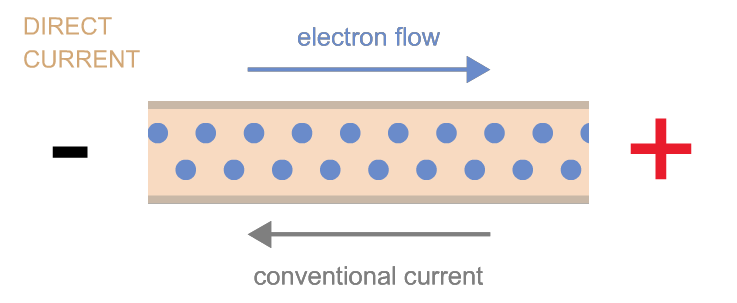
Alternating current (AC)
Conversely, AC electrons flow both ways (alternating) in a periodic cycle. The following graphic illustrates this sine-wave current over time.
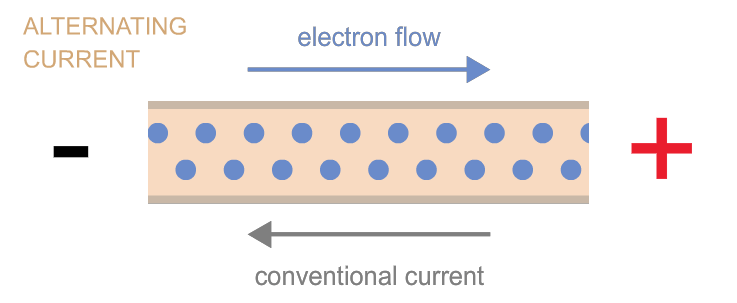
Bridging the DC to AC gap
To overcome the compatibility issues between DC and AC, electrical engineers created a device known as an inverter that converts DC into AC (and AC into DC if needed).
A pure sine wave inverter is a perfect example of an electronic device that:
- Produces alternating current (AC) from a direct current (DC) source.
- Delivers high-quality electric current, similar to utility standards (voltage: 230V, frequency: 50/60hz).
How does a pure sine wave inverter work?
In the previous section, you discovered that a pure sine wave inverter first converts DC into AC and then acts as a transformer by increasing input voltage (12V, 24V, 48…) to reach an output voltage of 230V, usable by all your household appliances.
Now let’s take a closer look at those two processes.
Converting DC to pure sine wave AC
This section looks at a simple working principle that illustrates how pure sine wave inverters work.
The challenge is to turn a straight line (DC) into a wave (AC) in which the current flows periodically in both directions. Let’s start with a simple switch.
Switching the DC current on and off periodically will give you a square-shaped current alternating between zero (switch off) and maximum value (switch on).
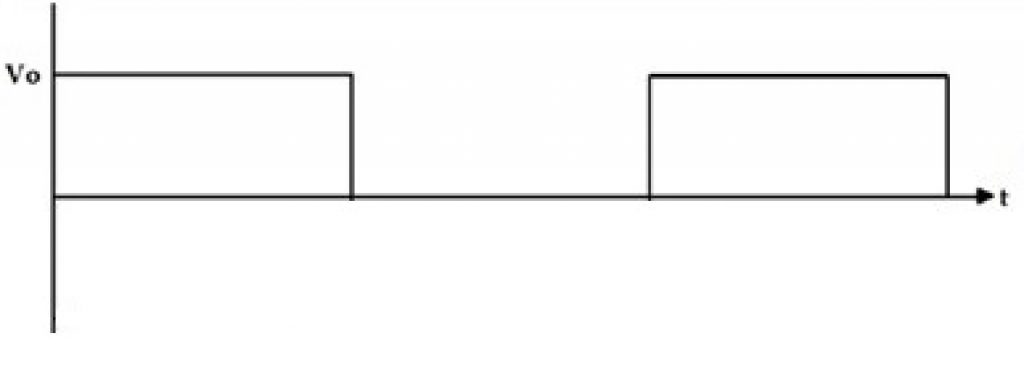
Now you have a periodical current that doesn’t flow in both directions and is still very far from a sine waveform.
To make the current flow in both directions, you’d need a kind of automated switch that’ll flip the incoming direct current back and forth by reversing the contact.
This can be illustrated as a rotating disk with criss-cross connections. The speed of the rotating disk will determine the frequency of the alternating current.
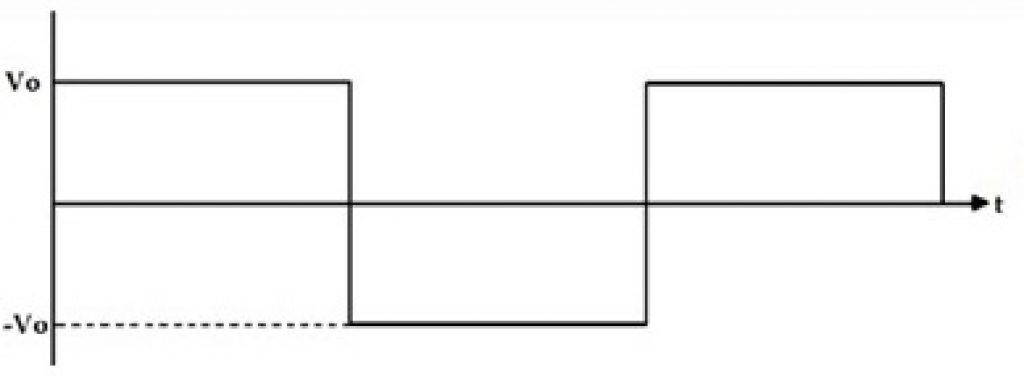
Now, you have a periodical current flowing in both directions. However, it’s still the shape of a square. It takes a bit more electronic circuits to smooth out the square into a nicely defined sine wave.
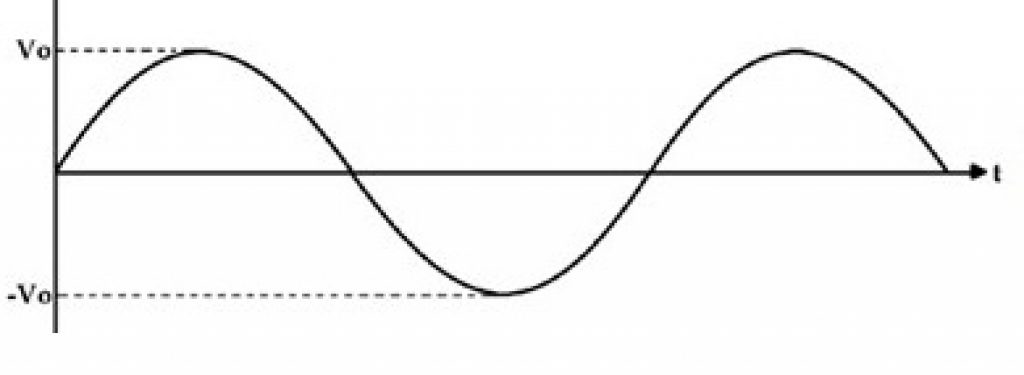
How do pure sine wave inverters increase the voltage?
DC is usually 12V, 24V, or 48V. Whereas AC is 230V.
The transformer will do the job. It’s an electromagnetic device made of an iron core wrapped with two coils of copper wire — the primary and secondary coils. The low voltage current enters through the primary coil, and the high voltage current exits out of the secondary coil.

In the end, the two coils are not in contact, and the current is transferred from one to another via electromagnetic induction.
The wiring density of the two coils controls the output voltage. In a step-up transformer (increasing the voltage), the secondary coil has a higher wiring density than the primary one.
Transformers are everywhere. For example, your cell phone and laptop chargers are step-down transformers.
Related reading: Enphase Vs. SolarEdge (Which inverter company should you choose?)
What is the difference between a pure and modified sine wave inverter?
Pure sine wave inverters and modified sine wave inverters are two types of power inverters used to convert direct current (DC) to alternating current (AC). While both inverters serve the same purpose, there are notable differences between them that make them suitable for different applications.
Waveform
The most significant difference between pure sine wave inverters and modified sine wave inverters is the waveform they produce. Pure sine wave inverters have a smooth, sinusoidal waveform similar to the waveform of the electricity the power grid provides. Conversely, modified sine wave inverters produce a stepped waveform that is not as smooth as the pure sine wave.
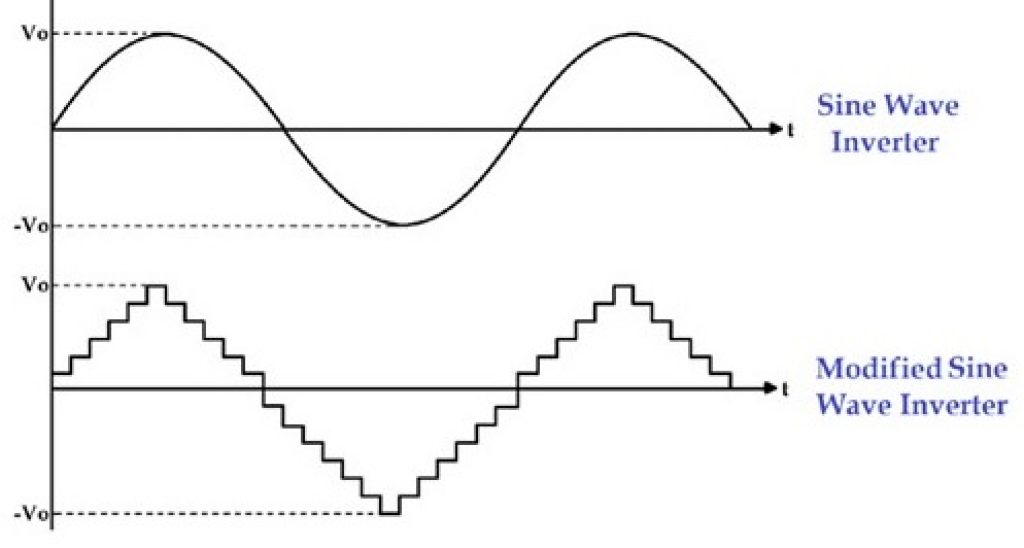
Compatibility
Pure sine wave inverters are compatible with all electronic devices, including sensitive ones like medical equipment, home theater systems, and computers. As such, a pure sine wave is the most optimal waveform for powering electronic equipment. It eliminates the risk of damage or interference that modified sine wave inverters may cause.
Modified sine wave inverters are suitable for powering less sensitive devices, such as power tools, refrigerators, and lights.
Efficiency
Pure sine wave inverters are more efficient than modified sine wave inverters since they convert DC power to AC power with little to no loss of power. Modified sine wave inverters have a lower conversion efficiency and may lose up to 20% of the power in the conversion process.
Price
On the downside, pure sine wave inverters are more expensive than modified sine wave inverters. This is because they are more complex and use advanced circuitry to produce a clean, smooth waveform.
Modified sine wave inverters are relatively simple and use fewer components, making them more affordable.
Noise and heating
Pure sine wave inverters produce less noise and heat than modified sine wave inverters. This is because a pure sine wave is a smooth waveform that does not generate as much electromagnetic interference as the stepped waveform produced by modified sine wave inverters.
Unfortunately, the heat generated by modified sine wave inverters can damage electronic devices and reduce their lifespan.
Solar panel compatibility
Pure sine wave inverters are compatible with all solar panels and are the preferred choice for solar-powered systems. In contrast, modified sine wave inverters may not work well with certain solar panels, such as thin-film panels.
Conclusion
In the end, the main differences between a modified (MSW) and pure sine wave inverter (PSW) can be summarized as follows:
| Current Quality | Efficiency | Price | For all appliances | |
|---|---|---|---|---|
| Current Quality | Efficiency | Price | For all appliances | |
| Pure Sine Wave | ++ | ++ | – | ++ |
| Modified Sine Wave | – | – | ++ | + |
What appliances need a pure sine wave inverter?
First of all, don’t throw away your modified sine wave inverter too quickly. Although the output current is not of the highest quality, it’s still worth using for applications with no sensitive electronics. For example, electric heaters or water pumps. However, they have lower efficiency levels and may overheat.
That said, almost all other appliances and electronic equipment will require a quality pure sine wave inverter. In addition, you need a pure sine wave if you connect your inverter to the grid, as with many solar installations.
A pure sine wave inverter will run your appliances smoothly as if they were connected to the utility grid.
Below you’ll find some common appliances and electronic devices that would only run with a pure sine wave inverter:
- LED TV.
- Microwaves.
- Refrigerators.
- Medical equipment.
- Variable speed electric motors.
For all the reasons mentioned above, we recommend that you purchase a modified sine wave inverter only if you are on a budget and are not concerned about the efficiency of your appliances.
Why are pure sine wave inverters so expensive?
Pure sine wave inverters provide a clean and reliable electric current that is of the same quality provided by your utility grid. They use high-end electronic components to achieve this high quality, unlike modified sine wave inverters that contain only cheap electronics.
Therefore, for a similar wattage output, a pure sine wave can be twice as expensive as a modified sine wave.
However, remember that pure sine wave inverters will protect your equipment and increase its life duration. In addition, you will save energy with a pure sine wave inverter because of its high efficiency (+90%).
What size pure sine wave inverter should you buy?
Pure sine wave inverters come in many sizes and power outputs to satisfy all needs.
Let’s first consider a car pure sine wave inverter:
Car inverter: max 1500W
Many pure sine wave inverter models offer a cigarette socket to connect directly to your car. The energy source will come from the car battery or the car alternator.
In this configuration, your maximum inverter wattage should be 1500 watts. You do not need to purchase a more powerful inverter simply because your car alternator cannot produce enough power.
A typical car alternator produces between 40 Amps and 120 Amps at 12V. Therefore, the maximum power of 480W to 1440W.
Don’t worry; 1500W of power is more than enough, and you can run many appliances and electronic devices simultaneously with this size inverter.
Solar inverter: 1kW-10kW
Pure sine wave inverters are widely used in solar off-grid and grid-connected systems.
Usually, the inverter is connected to the following components:
- Solar charge controller: This regulates solar panel output.
- Energy storage system (ESS): These systems come in many forms, both big ( the Powerwall+ and its alternatives) and small (LFP, LTO, AGM, and Gel batteries).
There is virtually no power limit for a solar inverter. However, most solar inverters ranging from 1kW to 10kW.
However, the rule of thumb would be to get an inverter as powerful as your solar panel array. For example, if you have 3kW of solar panels, then you should purchase a 3kW inverter.
Because you can easily upgrade your solar system, we recommend getting an inverter slightly more powerful than your solar panels.
Related reading: The Only Inverter Size Chart You’ll Ever Need
FAQs
How long can a pure sine wave inverter operate continuously?
A pure sine wave inverter can operate continuously as long as it has a stable power source, like a battery with sufficient charge, and is not overloaded by the connected appliances.
However, the continuous operating time is also dependent on factors like the efficiency of the inverter, the power consumption of connected appliances, and the capacity of the power source.
Is it possible to repair a malfunctioning pure sine wave inverter?
Yes, it is often possible to repair a malfunctioning pure sine wave inverter, depending on the extent and nature of the damage.
It’s recommended to have the inverter assessed by a professional who can determine whether a repair is feasible and cost-effective compared to replacement.
Can a pure sine wave inverter be used in conjunction with renewable energy sources other than solar, like wind or hydro power?
Yes, a pure sine wave inverter can be used with various renewable energy sources, including wind and hydro power.
The inverter can convert the DC produced by these renewable energy systems to AC, allowing it to be used by standard appliances or fed back into the grid.
Is there any regular maintenance required for pure sine wave inverters?
Typically, pure sine wave inverters require minimal maintenance. However, it’s important to regularly check the connections and ensure that the inverter is kept clean and is located in a well-ventilated area to prevent overheating. Regular checks for any signs of wear, damage, or loose connections can also aid in the longevity of the device.
How do pure sine wave inverters handle peak loads or surges in power demand?
Many pure sine wave inverters are designed to handle peak loads or surges in power demand for short periods, thanks to built-in surge protection features.
They can supply power above their rated continuous output to start high-demand appliances like refrigerators and air conditioners, which require a surge of power to start up but then operate at a lower power level.
Can I use a modified sine wave inverter temporarily if my pure sine wave inverter fails?
Yes, a modified sine wave inverter can be used as a temporary substitute if your pure sine wave inverter fails, but it’s crucial to ensure the connected appliances are compatible with modified sine wave output to avoid damage or reduced performance.
Be mindful that sensitive electronic equipment may experience issues or be damaged by the less smooth waveform of a modified sine wave inverter.
Final Thoughts
This article demonstrated that there are two types of inverters: modified sine wave and pure sine wave.
Pure sine wave inverters are made of high-quality electronics and are highly efficient in providing electric current with the same characteristics as your utility company. They will not damage your appliances or overheat them.
On the other hand, modified sine wave inverters are cheaper but less efficient and cannot run all types of devices.
In the end, there is no doubt that a pure sine wave inverter is a great investment – it will preserve your electronics and save you a lot of money over time.

